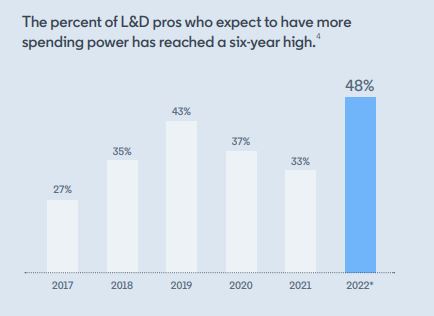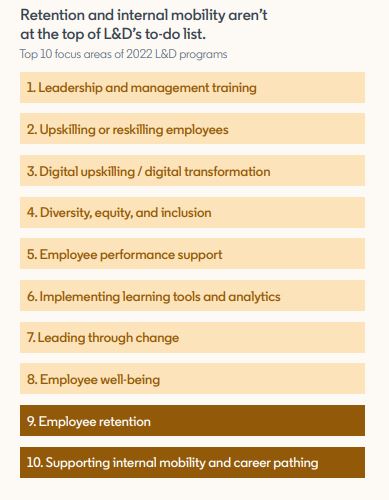More L&D opportunities could stop the ‘Great Resignation’
Employees will quit if they don’t get internal mobility and learning opportunities.
Why You Should Care
Workplace learning has never been more prioritized.
Employees want development opportunities, or they will look for a new job.
Learn LinkedIn's advice for how organizations can switch up their approaches to learning.
COVID-19 has pushed learning and development (L&D) further up the agenda.
72% of more than 1,400 global L&D professionals told LinkedIn that L&D was now a strategic function of the business. It is helping organizations adapt to change (87%) and will continue to reshape companies in 2022 (62%).
As Fosway Group’s director of research David Perring puts it in LinkedIn’s sixth workplace learning report: “If you want to be leading the world, you have to be learning.”
In addition, LinkedIn’s study found that L&D professionals’ spending power reached a six year high; this is expected to continue given that only 8% think their budget will decrease this year.

They are using this budget to focus on reskilling and upskilling workers, particularly in the realm of digital, as well as on training managers to support workers with career growth, and on the diversity and inclusion training.
Despite this, it seems HR teams are struggling to connect the dots between skills, internal mobility and retention. Retention and internal mobility are at the bottom of their to-do lists.

L&D and the ‘Great Resignation’
While L&D professionals are aware that internal mobility is a higher priority now than before COVID-19 (54%), the fact they overlook the link between skills, mobility and retention is a concern given that career development has been shown to be a leading cause of the ‘Great Resignation’.
LinkedIn’s study agreed that learning is essential for success in the ‘Great Reshuffle’ as the social media platform refers to the war for talent.
Employees now expect learning opportunities at work, they also want managers to get on board and support them in career growth. LinkedIn found that employees who feel their skills are not being put to good use in their current job are ten times more likely to look for a new job.
LinkedIn’s research also uncovered that companies good at career development were able to retain employees nearly twice as long (5.4 years vs 2.9 years) as those without good strategies.
So what do L&D teams need to do to win the war for talent?
LinkedIn argue they need to cultivate “a culture of internal mobility” by “giving employees access to on-the-job learning opportunities, such as mentorships, gigs, shadowing, and new jobs.”
HR leaders also need to continue to listen to employee feedback on what they want out of L&D programs – only 50% of the 1,400 leaders surveyed currently do this.
Data and analytics are essential to success; for instance, it helps HR teams to know where to spend their budget. They need to be smart, and rely on technology providers to help.
Ultimately, the main takeaway from LinkedIn’s 2022 report is for L&D professionals to never stop learning themselves; it means they can keep a finger on the pulse of the future of learning and ensure companies aren’t getting left behind in future disruptions to the world of work.
Sign up to the UNLEASH Newsletter
Get the Editor’s picks of the week delivered straight to your inbox!

Chief Reporter
Allie is an award-winning business journalist and can be reached at alexandra@unleash.ai.
